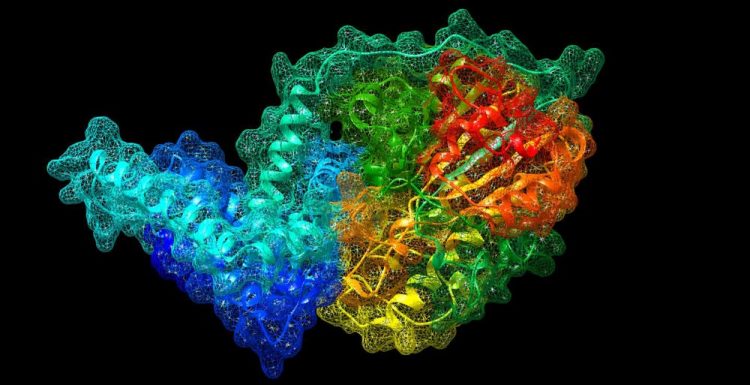New 'jumping' superbug gene discovered, resistant to last-resort antibiotic

The mcr-9 gene's protein structure graphic depicts the differing protein chains (solid color ribbons) and the protein surface (mesh) surrounding it. Credit: Ahmed Gaballa, Cornell University
Doctors deploy the antibiotic colistin when all other infection-fighting options are exhausted. But resistance to colistin has emerged around the globe, threatening its efficacy.
“This last-resort antibiotic has been designated a highest-priority antibiotic by the United Nations' World Health Organization, and the mcr-9 gene causes bacteria to resist it,” said Martin Wiedmann, food safety professor and senior author on the study, published May 7 in the journal mBio. “In treatments, if colistin does not work, it literally could mean death for patients. If colistin resistance spreads, a lot of people will die.”
Co-lead author Laura Carroll, a computational biologist and Cornell doctoral candidate, found mcr-9 in the genome of a strain of foodborne pathogen salmonella.
Mcr-9 is the latest in this new series of “mobilized colistin-resistance” genes – originally discovered in 2015. The National Center for Biotechnology Information, part of the National Institutes of Health, has added details about this new gene to its database. Medical professionals and others can now use this information to identify mcr-9 in bacteria isolated from food products and people.
Details about mcr-9 in national and international databases enable scientists to develop better prevention and treatment, explained Wiedmann. “This improves our ability to get an early warning,” he said.
Bacteria isolated from food products can now be tested for mcr-9, and patients can be screened for colistin-resistant bacteria, which possess mcr-9.
“If you go to a hospital and this gene is floating around, that can be trouble. The gene is moveable. It jumps,” Wiedmann said. “In a hospital setting, being able to screen a patient for resistance allows doctors and nurses to isolate the patient and maintain biosecurity.”
###
In addition to Carroll and Wiedmann, co-authors were microbiologist Ahmed Gaballa, postdoctoral researcher Claudia Guldimann and graduate students Lory Henderson and Genevieve Sullivan.
This work was funded by the National Science Foundation's Graduate Research Fellowship Program, with additional funding by the NSF Graduate Research Opportunities Worldwide, through a partnership with the Swiss National Science Foundation.
Cornell University has dedicated television and audio studios available for media interviews supporting full HD, ISDN and web-based platforms.
Media Contact
All latest news from the category: Health and Medicine
This subject area encompasses research and studies in the field of human medicine.
Among the wide-ranging list of topics covered here are anesthesiology, anatomy, surgery, human genetics, hygiene and environmental medicine, internal medicine, neurology, pharmacology, physiology, urology and dental medicine.
Newest articles

High-energy-density aqueous battery based on halogen multi-electron transfer
Traditional non-aqueous lithium-ion batteries have a high energy density, but their safety is compromised due to the flammable organic electrolytes they utilize. Aqueous batteries use water as the solvent for…

First-ever combined heart pump and pig kidney transplant
…gives new hope to patient with terminal illness. Surgeons at NYU Langone Health performed the first-ever combined mechanical heart pump and gene-edited pig kidney transplant surgery in a 54-year-old woman…

Biophysics: Testing how well biomarkers work
LMU researchers have developed a method to determine how reliably target proteins can be labeled using super-resolution fluorescence microscopy. Modern microscopy techniques make it possible to examine the inner workings…





















